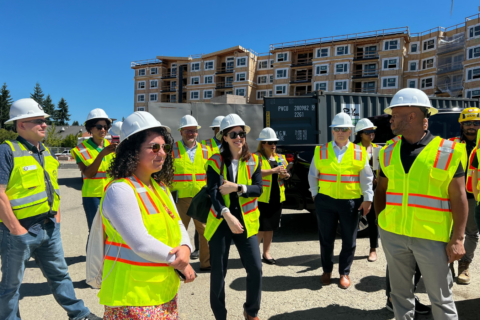Housing Supply Accelerator Convening
The Housing Supply Accelerator, a partnership between the National League of Cities (NLC) and the American Planning Association (APA), is dedicated to locally driven housing supply solutions. Its mission is to improve local capacity, identify critical solutions, and refine processes that align the efforts of public and private stakeholders in the housing sector aimed at meeting housing needs at the local level.
Over the course of this year, APA and NLC have hosted three convenings to examine the key drivers of the nation’s local housing supply challenges: construction and development, finance, and land use and regulations. On September 28, 2023, NLC and APA convened the Housing Supply Accelerator’s steering committee along with core, regional, and national stakeholders in Washington, D.C., to discuss land use and regulations.
The conversation explored several regulatory processes that underpin development, from locally led zoning reform and permitting to building codes and standards. In attendance at the convening were a diverse range of stakeholders representing a distinct facet of the housing supply ecosystem and its interconnected fields. Stakeholders came together with a common goal of examining the role of regulatory processes in facilitating housing production to address shortages.
Key Takeaways
From the comprehensive discussion, a recurring theme emerged throughout the convening—a shared commitment to enhancing transparency, predictability, and flexibility within the regulatory landscape. These three elements are pivotal to addressing the housing supply challenges given the intricacies of the regulatory processes. Other key takeaways included:
- Understanding the scope and limitations of zoning
- Identifying gaps and opportunities for innovations
- Embracing change.
Understanding of Zoning and Other Regulations
During the convening, the complex and interconnected nature of zoning regulations, which define land use, building design, and approval processes, was acknowledged. To navigate this complexity, it was suggested that local municipalities take inventory of their zoning regulations and other pertinent land-use policies. By taking inventory, communities can understand the housing typologies permissible in their jurisdiction and locate the areas in their municipality that can support housing growth and the areas with limitations. In addition to reviewing housing-related regulations, it was suggested that municipalities should give attention to:
- Equity: To enable a wide spectrum of housing options that are diverse, attainable, and equitable for all members of the community, equity should be a fundamental component in zoning provisions. APA’s Equity in Zoning Policy Guide provides guidance for addressing and alleviating the disproportionate impacts of zoning.
- Usability: To enhance the coordination of housing regulations, such as zoning, subdivision rules, and environmental reviews, municipalities could consider the adoption of a Unified Development Ordinance to consolidate regulations into a single document, simplifying the regulatory framework and eliminating inconsistencies and overlaps.
- Innovation: To support innovation, investigate if land use and regulations have the flexibility to accommodate housing innovations, including emerging housing options like 3D printing, manufactured, and modular housing.
Identify Gaps and Opportunities for Innovation
Stakeholders were reminded during the convening once a foundational understanding of what is allowed within the zoning map of a municipality is established, it is useful to conduct a comprehensive assessment of the building permitting process. This includes identifying gaps and opportunities to streamline the process both for the applicants and for internal operational efficiency. Technology was highlighted to enhance efficiency and transparency in the permitting processes through digitalization and/or automation. However, stakeholders were cautioned to consider that the capacity and timeline for implementing such changes can vary among municipalities.
- In Memphis, Tennessee, Memphis and Shelby County’s Division of Planning and Development has worked to streamline their administrative processes and eliminate barriers within their permitting and review procedures. Some key examples include their adoption of online permit applications and concurrent reviews of site plans and building permit applications, resulting in reduced review times and permit issuance.
- In Los Angeles, California, the City of Los Angeles’ Department of Building and Safety introduced the Standard Plan Program to ensure a simplified permitting process for the design and construction of Accessory Dwelling Units (ADUs).
Embracing Change
Given the evolving landscape of our communities, their needs, and the environment, stakeholders were advised during the convening to recognize change as a natural aspect of the process. More specifically, stakeholders explored how building codes and land use regulations can be updated to effectively serve the current and changing needs of their communities. Adaptation may involve frequent building code updates and revisiting zoning ordinances, especially where cities have adopted and updated a comprehensive plan. These examples underscore the importance of remaining adaptable to evolving community needs and goals.
- In Minneapolis, Minnesota, the City of Minneapolis adopted a widespread, equity-led zoning reform process that prioritized housing access and opportunity in every neighborhood in the city. This initiative involved extensive community engagement and data-driven analysis to understand the impact of existing zoning regulations.
- In Alexandria, Virginia, the City of Alexandria is embarking on a series of locally led zoning reforms to increase housing opportunities within the locality. These reforms include raising allowable density by increasing the units per acre in single-family zones and reducing parking requirements.
Additionally, the convening identified areas that require further exploration, such as developing infrastructure to support increased housing supply, and building housing for a resilient future.
Special thanks to our program partners for joining the convening, including the Mortgage Banker Association, National Association of Home Builders and National Association of Realtors; federal representatives from the U.S. Department of Housing and Urban Development, Federal Transit Administration and the White House Domestic Policy Council; and representatives from national and regional organizations including AARP, American Institute of Architects (AIA), ASHRAE, Center for Community Progress, Clarion Associates, Esri, International Code Council, Lincoln Institute of Land Policy, Melville Charitable Trust, Mercatus Center, National Apartment Association, National Association of Counties, National Association of Housing and Redevelopment Officials, National Association of Regional Councils, Pallet Shelter, Pew Charitable Trusts, Smart Growth America, Steward of Affordable Housing for the Future and Zone Co.
A partnership between the National League of Cities (NLC) and the American Planning Association (APA), the Housing Supply Accelerator is a national campaign to improve local capacity, identify critical solutions, and refine processes that enable communities and developers to work together to produce, preserve and provide a diverse range of quality housing by aligning the efforts of public and private stakeholders in the housing sector to meet housing needs at the local level.
Interested in becoming an NLC member? Start your membership application now!








